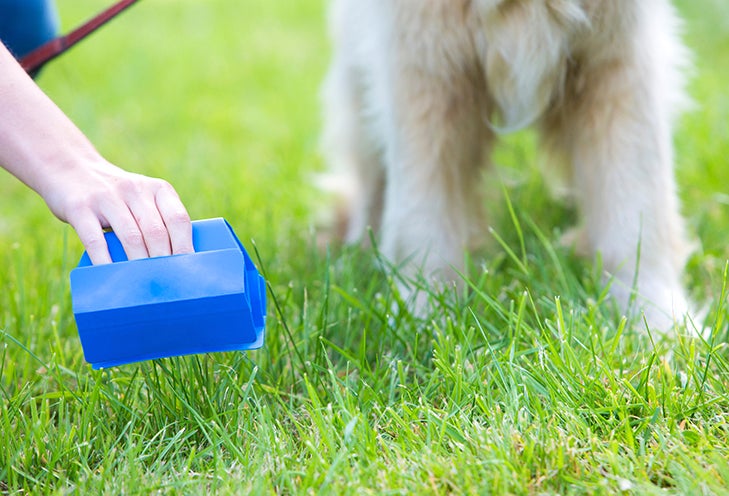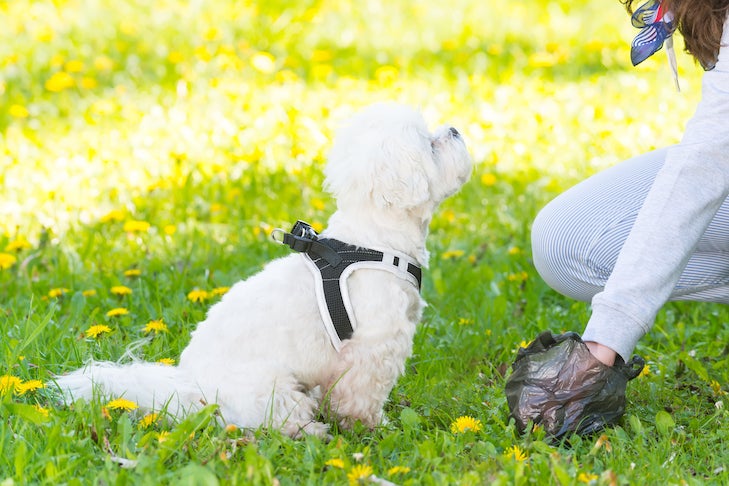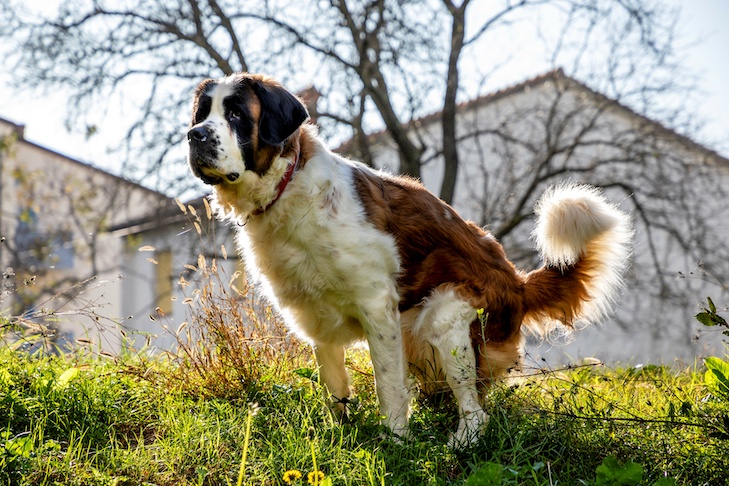AKC is a participant in affiliate advertising programs designed to provide a means for sites to earn advertising fees by advertising and linking to akc.org. If you purchase a product through this article, we may receive a portion of the sale.
If you can get over the initial “ick” factor, composting your dog’s poop is absolutely worth considering. It’s environmentally friendly option, of course. Plus, you can use it as a natural and surprisingly odor-free fertilizer that plants love.
Why Is Dog Poop Such a Problem Environmentally?
Are you one of the millions of owners that uses “biodegradable” bags to scoop your dog’s poop before putting it in the trash? Maybe you walk on remote trails and flick your dog’s waste into the bushes, thinking it’s fine because it will decompose naturally, and no one is going to tread on it there.
Rose Seemann is the founder of the pet composting company Envirowagg and author of The Pet Poo Pocket Guide: How to Safely Compost and Recycle Pet Waste. “There’s a huge amount of dog and cat waste now—as much as there was human waste in the fifties, and we’ve got septic systems for that. Recently as much as 60% of households have dogs or cats, and just a few years ago, it was 40%. So we’ve got to do something with this dog waste,” she explains.
Much of the waste we scoop ends up in landfill. Unfortunately, unless it’s a highly-rated compostable type, the bag used will take many years to fully degrade, if at all.
Professor Leigh Ackland is the Director of the Centre for Cellular & Molecular Biology in the School of Life and Environmental Sciences at Deakin University in Melbourne, Australia. She has been composting her own dog’s poop for years.
She explains that poops left to break down au natural commonly end up making their way into our waterways through runoff. Fecal coliform bacteria is a significant problem. “You will get algal blooms or bacterial proliferation because of all the extra nutrients from the dog poop, and the water becomes contaminated, with potential health risks.”

Is Composting Dog Poop Safe and Practical?
The two biggest worries about composting dog poop are generally the smell and the risk of parasites and germs.
Professor Ackland is keen to reassure owners that compost containing dog poop has little to no odor. “Compost that you make has lost all of its smell because all the molecules have broken down into their individual components,” she explains. If anything, it only has an inoffensive earthy aroma within a matter of days.
In terms of the risk of parasites and germs, the first thing to consider is that you’ll only be composting your own dog’s poop. If they get regular veterinary care and treatments for common parasites, the risk is minimal. “The fact is, if there were any pathogens, they are suited to living inside humans or dogs, and once you put those pathogens in the compost, unless there are masses of them, they will probably just die,” adds Ackland.
Ackland has also established that there are no concerns regarding antiparasitic treatments, like those for heartworm. “It is such a small amount once it passes through the dog that it is insignificant,” she says.
The heat generated in a large, adequately tended compost pile would kill off any pathogens anyway. Temperatures can reach as much as 160 degrees Fahrenheit in a fresh pile, especially if it contains grass cuttings. These cuttings heat up so quickly they can even cause the pile to ignite.
Even if you don’t plan to keep up with the maintenance to ensure that your compost pile reaches those temperatures, providing you aren’t using the compost on an edible harvest, any risk is minimal.
Ann Rippy worked for the USDA on a study involving dog kennel operators to evaluate the possibility of composting dog waste in northern climates. After the study, the team produced a detailed guide for a high heat composting process that ensures any pathogens and parasites are killed off. “If you are not worried about killing off any pathogens, you can do what we affectionately call “passive composting”, which is generally less intensive,” she suggests. “So, if the dog gets regular veterinary care and you are using the passive compositing technique, the temperatures are not going to be such a big issue.” But it, of course, depends on a person’s comfort with risk. “If somebody has toddlers, playing in the yard and putting things in their mouth, then maybe you might want to be more careful,” Rippy continues.

Composting Options
There are lots of options when it comes to the actual composting process. You just need a mix of nitrogen-rich, wet organic materials (food waste, grass cuttings, poop) and dry, carbon-rich materials (sawdust, leaves, shredded paper).
Composting in a Lawn
If you have a large yard and frequently mow your lawn, consider adding your dog’s poop to a traditional composting pile. Seemann humorously likens this method to building and baking a lasagne:
“You keep covering the material with sawdust or wood chips, or whatever you have to hand. Any kind of carbon is a bulking agent to cover it, and it also keeps the smell in. When you get a pile about 3 feet high, start a second pile and layer it like the first…,” she explains. “As the lasagne is baking on the first pile, you poke your shovel in, and it should stop smelling like poop. Then you turn it and start working on the temperature. It gets hot on the inside, cool on the outside, and you keep turning from time to time until it stops getting hot inside. Then you can leave it for months, and you will have a nice smelling compost for using on your ornamental plants, and it is really rich, and the plants like it.”
Composting in an Apartment
If you don’t have a yard, it’s still possible to compost in an apartment environment. Rippy is a fan of vermosting, which involves using worms in a bin to convert the organic material. However, she admits she hasn’t tried it with dog waste. “I don’t think I would keep a dog waste vermicompost system under the kitchen sink,” she notes. She goes on to explain that she “suspects you don’t get the rapid reduction of odors that we see with traditional aerobic decomposition. If the climate is mild the bin could be kept outside out of direct sunlight. A heated garage may work in the winter in cool climates.”
Seemann also mentions that she has heard tales of mixed success when adding dog poop to the food waste. “Some say that you put the food in with the poop and the worms will always go for the nice food, and some people say it is okay to mix it.”

Bokashi
You may even want to opt for an increasingly popular method known as Bokashi. Unlike most composting techniques, this involves an anaerobic process. This process requires you deprive the organic waste of oxygen as much as possible. It results in a fermented, rather than fully composted, material.
Seemann points out that it’s all about finding out what is best for you and your lifestyle. “That’s what is so cool about composting, you can do it anywhere, and there are so many different ways.”
Hire a Professional
Oh, and if you truly can’t face adding the poop to your composting pile, or at-home composting just seems too much effort, Rippy reminds us of another convenient option worth considering. She explains that many states have “professional yard cleaners that have set up composting systems. So this is another option for dog owners, to have them come in once a week or so to collect the poop.”

